Abstract
There is considerable clinical and experimental evidence of the benefit of late reperfusion of infarct-related arteries, referred to as the open artery hypothesis, in patients with acute myocardial infarction who presented too late to salvage at-risk ischemic myocardium. In addition to myocardial salvage, reperfusion of the infarct-related artery prevents infarct expansion, reduces development of ventricular remodeling, and decreases ventricular arrhythmia. The Occluded Artery Trial recently answered a major question related to the open artery hypothesis in a high-risk, asymptomatic patient with an occluded infarct artery. In this review, clinical and experimental evidence of the benefit of the open artery hypothesis will be discussed.
Go to : 
References
1. Braunwald E. Myocardial reperfusion, limitation of infarct size, reduction of left ventricular dysfunction, and improved survival: should the paradigm be expanded? Circulation. 1989; 79:441–4.
2. Kim CB, Braunwald E. Potential benefits of late reperfusion af infracted myocardium: the open artery hypothesis. Circulation. 1993; 88:2426–36.
4. Yousef ZR, Marber MS. The open artery hypothesis: potential mechanisms of action. Prog Cardiovas Dis. 2000; 42:419–38.

5. Stack RS, O'Connor CM, Mark DB, et al. Coronary perfusion during acute myocardial infarction with a combined therapy of coronary angioplasty and high dose intravenous streptokinase. Circulation. 1988; 77:151–61.
6. Cigarroa RG, Lange RA, Hillis LD. Prognosis after acute myocardial infarction in patient with and without residual anterograde coronary blood flow. Am J Cardiol. 1989; 64:155–60.
7. Trappe HJ, Lichtlen PR, Klein H, Wenzlaff P, Hartwig CA. Natural history of single vessel disease: risk of sudden coronary death in relation to coronary anatomy and arrhythmia profile. Eur Heart J. 1989; 10:514–24.

8. Pfeffer MA, Lamas GA, Vaughan DE, Parisi AF, Braunwald E. Effect of captopril on progressive ventricular dilatation after anterior myocardial infarction. N Engl J Med. 1988; 319:80–6.

9. Lamas GA, Flaker GC, Mitchell G, et al. Effect of infarct artery patency on prognosis after acute myocardial infarction. Circulation. 1995; 92:1101–9.

10. Pfeffer MA, Braunwald E. Ventricular remodeling after myocardial infarction: experimental observations and clinical implications. Circulation. 1990; 81:1161–72.

11. The GUSTO Angiography Investigators. The effects of tissue plasminogen activator, streptokinase, or both on coronary artery patency, ventricular function, and survival after acute myocardial infarction. N Engl J Med. 1993; 329:1615–22.
12. Yoo BS, Yoon J, Park KS, et al. The effect of thrombolysis on the status of infarct-related coronary artery and left ventricular function in acute myocardial infarction. Korean Circ J. 1995; 25:738–46.

13. Hochman JS, Lamas GA, Buller CE, et al. Coronary intervention for persistent occlusion after myocardial infarction. N Engl J Med. 2006; 355:2395–407.

14. Reimer KA, Lowe JE, Rasmussen MM, Jennings RB. The wavefront phenomenon of ischemic cell death: I. myocardial infarct size vs duration of coronary occlusion in dogs. Circulation. 1977; 56:786–94.
15. Reimer KA, Jennings RB. The “wavefront phenomenon” of myocardial ischemic cell death: II. transmural progression of necrosis within the framework of ischemic bed size (myocardium at risk) and collateral flow. Lab Invest. 1979; 40:633–44.
16. DeWood MA, Spores J, Notske R, et al. Prevalence of total coronary occlusion during the early hours of transmural myocardial infarction. N Engl J Med. 1980; 303:897–902.

17. Gruppo Italiano per lo Studio della Streptochinasi nell'Infarto Miocardico (GISSI). Effectiveness of intravenous thrombolytic treatment in acute myocardial infarction. Lancet. 1986; 1:397–402.
18. ISIS-2 (Second International Study of Infarct Survival) Colla-bolative Group. Randomized trial of intravenous streptokinase, oral aspirin, both, or neither among 17,187 cases of suspected acute myocardial infarction: ISIS-2. Lancet. 1988; 2:349–60.
19. Braunwald E. The path to myocardial salvage by thrombolytic therapy. Circulation. 1987; 76:II2–7.
20. White HD, Norris RM, Brown MA, Brandt WT, Whitlock RM, Wild CJ. Left ventricular end-systolic volume as the major determinant of survival after recovery from myocardial infarction. Circulation. 1987; 76:44–51.

21. Serruys PW, Simoons ML, Suryapranata H, et al. Preservation of global and regional left ventricular function after early thrombolysis in acute myocardial infarction. J Am Coll Cardiol. 1986; 7:729–42.

22. White HD, Norris RM, Brown MA, et al. Effect of intravenous streptokinase on left ventricular function and early survival after acute myocardial infarction. N Engl J Med. 1987; 317:850–5.

23. Sheehan FH, Doerr R, Schmidt WG, et al. Early recovery of left ventricular function after thrombolytic therapy for acute myocardial infarction: an important determinant of survival. J Am Coll Cardiol. 1988; 12:289–300.

24. Bates ER, Califf RM, Stack RS, et al. Thrombolysis and Angioplasty in Myocardial Infarction (TAMI-1) trial: influence of infarct location on arterial patency, left ventricular function and mortality. J Am Coll Cardiol. 1989; 13:12–8.

25. Fibrinolitic Therapy Trialists (FTT) Collaborative Group. Indications for fibrinolytic therapy in suspected acute myocardial infarction: collaborative overview of early mortality and major morbidity results from all randomized trials of more than 1000 patients. Lancet. 1994; 343:311–22.
26. The GUSTO investigators. An international randomized trial comparing four thrombolytic strategies for acute myocardial infarction. N Engl J Med. 1993; 329:673–82.
27. Ohman EM, Califf RM, Topol EJ, et al. Consequences of reoc-clusion after successful reperfusion therapy in acute myocardial infarction. Circulation. 1990; 82:781–91.

28. Roe MT, Ohman EM, Mass AC, et al. Shifting the open-artery hypothesis downstream: the quest for optimal reperfusion. J Am Coll Cardiol. 2001; 37:9–18.

29. Kim PJ, Jung HO, Koh YS, et al. Comparison of TIMI frame count and TIMI myocardial perfusion grade in assessment of myocardial reperfusion after primary angioplasty for acute myocardial infarction. Korean Circ J. 2003; 33:864–70.

30. Kim CM. Left ventricular remodeling following myocardial infarction. Korea J Intern Med. 1993; 45(Suppl):58–67.
31. Hutchins GM, Bulkley BH. Infarct expansion versus extension: two different complications of acute myocardial infarction. Am J Cardiol. 1978; 41:1127–32.

32. Kim CM, Kim HJ. Effect of 2-(3-benzoyl-phenyl)-prophyonic acid on healing of experimental myocardial infarction in rats. J Catholic Med Coll. 1987; 40:971–83.
33. Kim CM, Kim SR, Youn HJ, Lee MY. Choi KB, Hong SJ. Two-dimensional echocardiographic predictors of ventricular enlargement after acute myocardial infarction. Korean Circ J. 1996; 26:455–64.
34. St John Sutton M, Pfeffer MA, Plappert T, et al. Quantitative two-dimensional echocardiographic measurements are major predictors of adverse cardiovascular events after acute myocardial infarction. Circulation. 1994; 89:68–75.
35. Oh BH, Seo JD, Lee YW. Effects of converting enzyme inhibitor on the left ventricular remodeling after coronary artery reperfusion in rats. Korean Circ J. 1995; 25:499–509.

36. Lee JM, Kim CM, Youn HJ, et al. The effects of carvedilol on ventricular remodeling after myocardial infarction in rats. Korean Circ J. 2001; 31:1171–84.

37. Hochman JS, Choo H. Limitation of myocardial infarct expansion by reperfusion independent of myocardial salvage. Circulation. 1987; 75:299–306.

38. Kim CM, Park IS, Kim CC, et al. Effect of reperfusion on experimental myocardial infarction in rats. Korean Circ J. 1988; 18:57–67.
39. Carlye WC, Jacobson AW, Judd DL, et al. Delayed reperfusion alters matrix metalloproteinase activity and fibronectin mRNA expression in the infarct zone of the ligated rat heart. J Mol Cell Cardiol. 1997; 29:2451–63.
40. Abbate A, Bussani R, Biondi-Zoccai GG, et al. Persistent in-farct-related artery occlusion is associated with an increased myocardial apoptosis at postmortem examination in humans late after an acute myocardial infarction. Circulation. 2002; 106:1051–4.

41. Kim YK, Han DS, Lee MY, et al. Apoptosis in ischemia-re-perfused myocardium of rabbit. Korean Circ J. 1997; 27:1017–26.

42. Pirzada FA, Weiner JM, Hood WB Jr. Experimental myocardial infarction: accelerated myocardial stiffening related to coronary reperfusion following ischemia. Chest. 1978; 74:190–5.
43. Ganote CE. Contraction band necrosis and irreversible myocardial injury. J Mol Cell Cardiol. 1983; 15:67–73.

44. Kloner RA, Ellis SG, Lange R, Braunwald E. Studies of experimental coronary artery reperfusion: effects on infarct size, myocardial function, biochemistry, ultrastructure and microvascular damage. Circulation. 1983; 68:I8–15.
45. Reichenbach DD, Benditt EP. Myofibrillar degeneration: a response of the myocardial cell to injury. Arch Pathol. 1968; 85:189–99.
46. Opitz CF, Finn PV, Pfeffer MA, Mitchell GF, Pfeffer JM. Effects of reperfusion on arrhythmias and death after coronary artery occlusion in the rat: increased electrical stability independent of myocardial salvage. J Am Coll Cardiol. 1998; 32:261–7.

47. Cripps TR, Malik M, Farrell TG, Camm AJ. Prognostic value of reduced heart rate variability after myocardial infarction: clinical evaluation of a new analysis method. Br Heart J. 1991; 65:14–9.

48. Hohnloser SH, Frank P, Klingenheben T, Zabel M, Just H. Open infarct artery, late potentials, and other prognostic factors in patients after acute myocardial infarction in the thrombolytic era: a prospective trial. Circulation. 1994; 90:1747–56.

49. Lange RA, Cigarroa RG, Wells PJ, Kremers MS, Hills LD. Influence of antegrade flow in the infarct artery on the incidence of late potentials after acute myocardial infarction. Am J Cardiol. 1990; 65:554–8.
50. Kleiger RE, Miller JP, Bigger JT Jr, Moss AJ. Decreased heart rate variability and its association with increased mortality after acute myocardial infarction. Am J Cardiol. 1987; 59:256–62.

51. Yoo KD, Youn HJ, Chung WS, et al. The effect of autonomic deneervation on ventricular tachyarrhythmia in the ischemia and the reperfusion of canine heart. Korean Circ J. 2001; 31:567–75.
52. Held PH, Yusef S. Effects of beta-blockers and calcium channel blockers in acute myocardial infarction. Eur Heart J. 1993; 14(Suppl F):18–25.
53. Cho IH, Lee JY, Shin DG, et al. Influence at autonomic nervous system in occlusion and reperfusion arrhythmia. Korean Circ J. 1990; 20:369–80.
54. Mortara A, Specchia G, La Rovere MT, et al. Patency of infarct-related artery: effect of restoration of anterograde flow on vagal reflex. Circulation. 1996; 93:1114–22.
55. Berger PB, Ellis SG, Holmes DR Jr, et al. Relationship between delay in performing direct coronary angioplasty and early clinical outcome in patients with acute myocardial infarction. Circulation. 1999; 100:14–20.

56. O'Neill WW, Weintraub R, Grines CL, et al. A prospective, placebo-controlled, randomized trial of intravenous streptokinase and angioplasty versus lone angioplasty therapy of acute myocardial infarction. Circulation. 1992; 86:1710–7. .
57. Grines CL, Browne KF, Marco J, et al. A comparison of immediate angioplasty with thrombolytic therapy for acute myocardial in-farcton. N Engl J Med. 1993; 328:673–9.
58. Keeley EC, Boura JA, Grines CL. Primary angioplasty versus intravenous thrombolytic therapy for acute myocardial infarction: a quantitative review of 23 randomized trials. Lancet. 2003; 361:13–20.
59. Brodie BR, Stuckey TD. Mechanical reperfusion theraphy for acute myocardial infarction: stent PAMI, ADMIRAL, CADILLAC and beyond. Heart. 2002; 87:191–2.
60. Weaver WD, Cerqueira M, Hallstrom AP, et al. Prehospital initiated versus hospital initiated thrombolytic therapy. JAMA. 1993; 270:1211–6.
61. LATE Study Group. Late Assessment of Thrombolytic Efficacy (LATE) with alteplase 6–24 hours after the onset of acute myocardial infarction. Lancet. 1993; 342:759–66.
62. EMERAS (Estudio Multicentrico Estrepquinasa Republicas de America del sul Collaborative Group). A randomized trial of late thrombolysis in patients with suspected acute myocardial infarction. Lancet. 1993; 342:767–72.
63. Topol EJ, Califf RM, Vandormael M, et al. A randomized trial of late reperfusion therapy for acute myocardial infarction. Circulation. 1992; 85:2090–9.
64. Horie H, Takahashi M, Minai K, et al. Lonr-term beneficial effect of late reperfusion for acute anterior myocardial infarction with percutaneous transluminal coronary angioplasty. Circulation. 1998; 98:2377–82.
65. Yousef ZR, Redwood SR, Bucknall CA, Sulke AN, Marber MS. Late intervention after acute myocardial infarction: effects on left ventricular size, function, quality of life, and exercise tolerance. J Am Coll Cardiol. 2002; 40:869–76.
66. Yousef ZR, Marber MS, Redwood SR. Late opening of the infarct related artery: an open or shut case? Heart. 2005; 91:561–2.
Go to : 
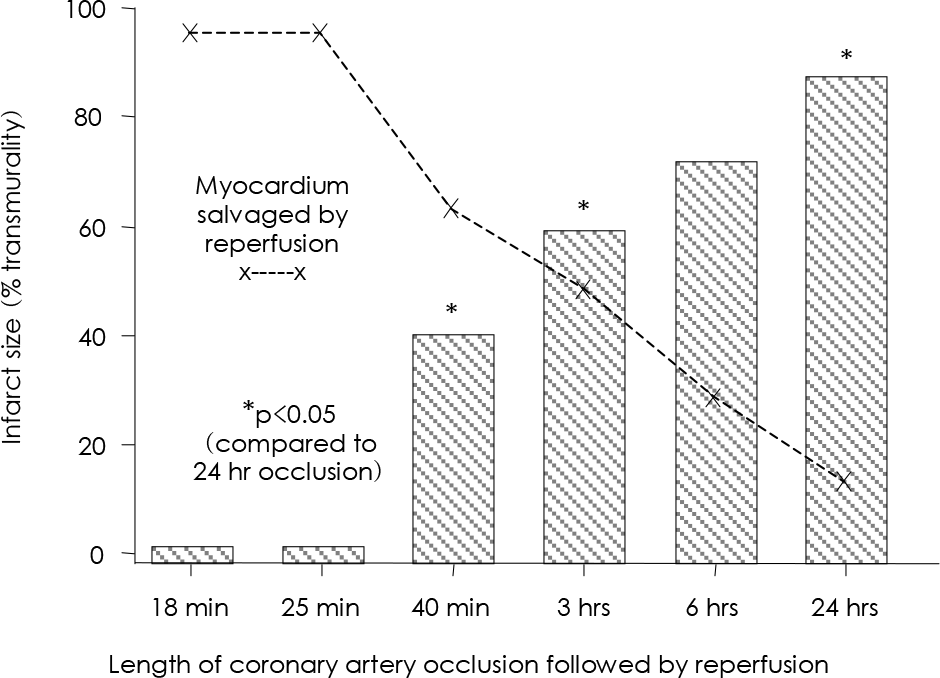 | Fig. 1.Temporary circumflex coronary artery ligation and infarct size in a dog. Reperfusion after 18 and 25 minutes represents a period of reversible ischemia in which infarct transmurality is negligible. After 40 minutes, 3 hours, and 6 hours, however, reperfusion results showed a graded and time-dependent limitation of infarct size. The infarct size limitation following reperfusion after 40 minutes and 3 hours is significant compared with prolonged coronary artery occlusion (24 hours).4)
|
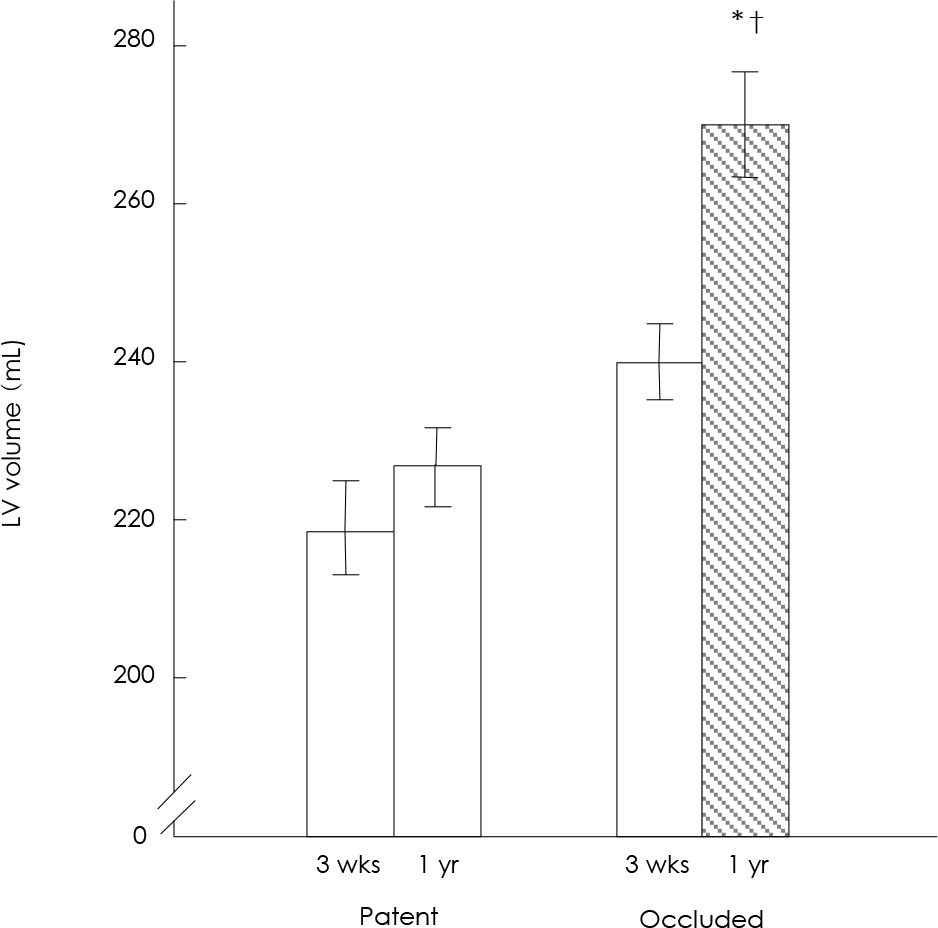 | Fig. 2.Bar graph of left ventricular volume as determined by biplane angiography in survivors of first anterior Q wave infarction with paired studies performed at 3 weeks and 1 year after this initial infarction. Patients with a patent left anterior descending coronary artery at the initial catheterization did not demonstrate progressive enlargement over time. In contrast, patients with an occluded vessel supplying their infarcted region showed time-dependent ventricular enlargement; by 1 year (solid bar), these enlargements had increased above their baseline size († p<0.05) and had greater volumes (*p<0.05) than patients with patent vessels.10) LV: left ventricle. |
 | Fig. 4.Photographs of transverse sections of rat left ventricle (LV) subjected to coronary occlusion for 21 days. A: noninfarcted (normal) sham-control rat with normal thickness of the LV wall. B: myocardial infarction without treatment (control), large transmural infarction of the anterior wall showing considerable thinning of the infarct compared with the septal wall and sham-control. The LV cavity was dilated. C: myocardial infarction with 2-(3-benzoyl-phenyl)-propionic acid(ketoprofen) injection. The LV cavity was more dilated than in the control, and the infarct scar is thinner than that of the control (A: hematoxylin-eosin stain, B&C: Masson's trichrome stain).32)
|
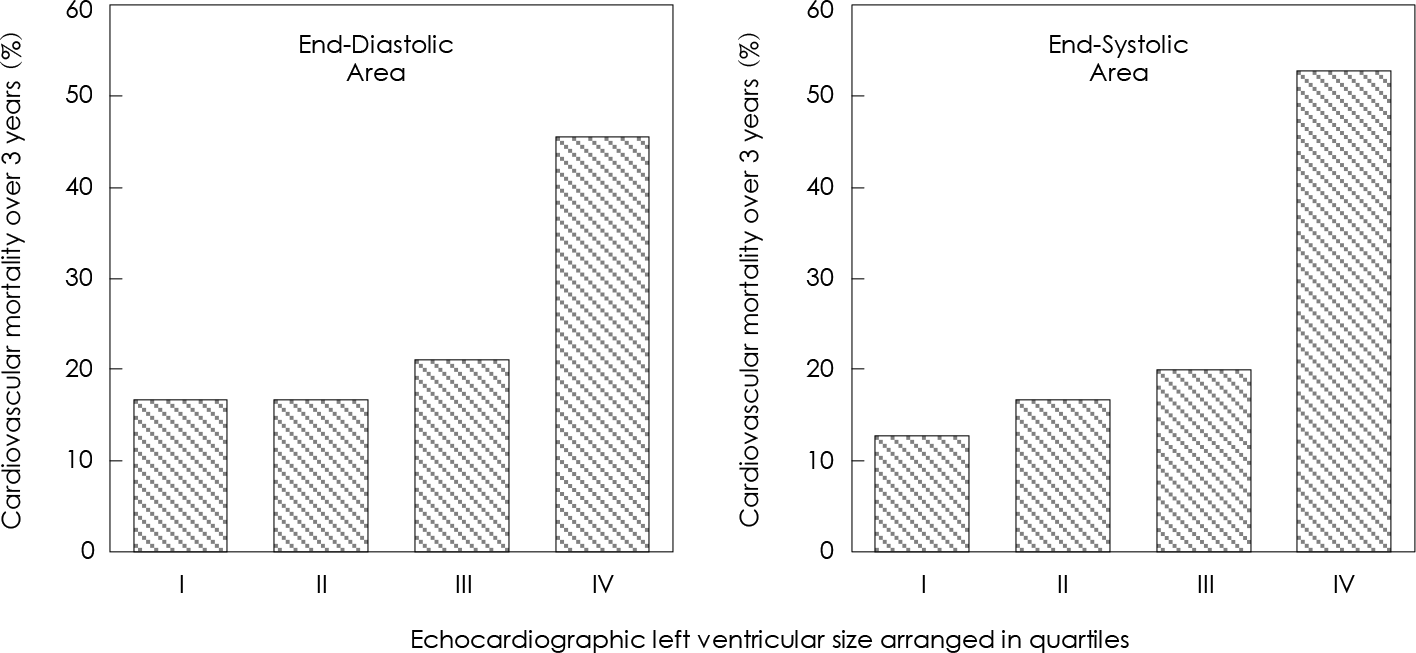 | Fig. 5.Baseline left ventricular size and subsequent cardiovascular mortality. Baseline end-diastolic and end-systolic areas measured 11 days post-infarction are represented in quartiles. The figure shows that the 3-year cardiovascular mortality rate was greatest in the patients whose left ventricular size was in the upper quartile early post-infarction.34)
|




 PDF
PDF ePub
ePub Citation
Citation Print
Print


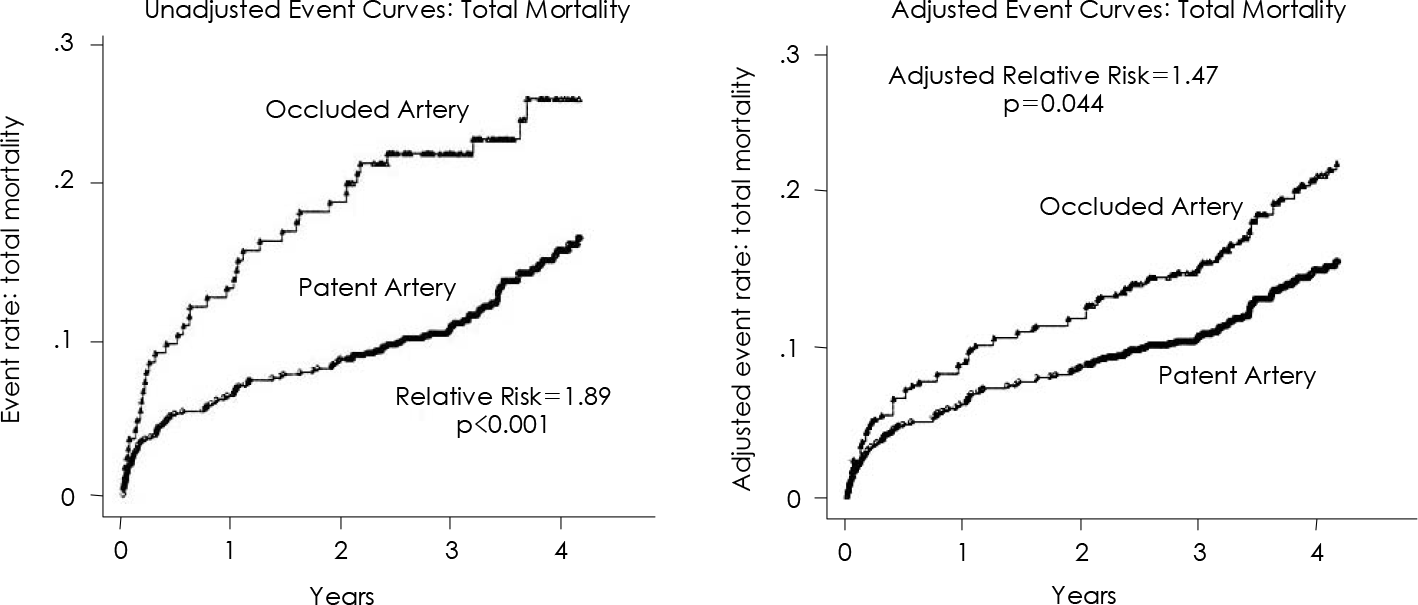
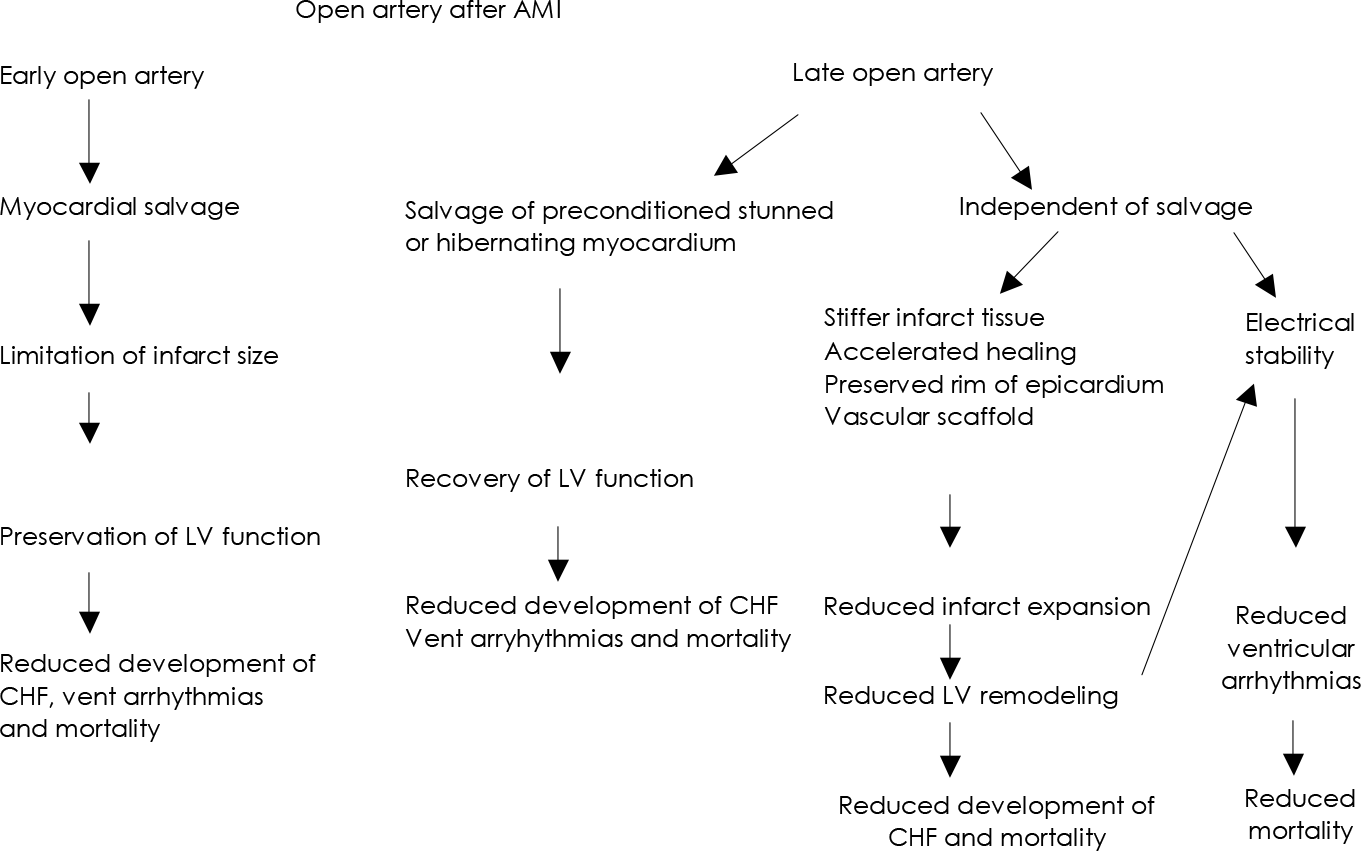
 XML Download
XML Download